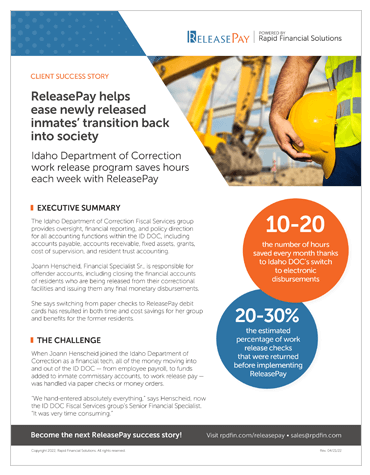ReleasePay helps ease newly released inmates’ transition back into society
ReleasePay helps ease newly released inmates’ transition back into society
Idaho Department of Correction work release program saves hours each week with ReleasePay
10-20
the number of hours saved every month thanks to Idaho DOC’s switch to electronic disbursements
20-30%
the estimated percentage of work release checks that were returned before implementing ReleasePay
1 week
the annual estimated time it took ID DOC to perform escheatment processes before using ReleasePay
EXECUTIVE SUMMARY
The Idaho Department of Correction Fiscal Services group provides oversight, financial reporting, and policy direction for all accounting functions within the ID DOC, including accounts payable, accounts receivable, fixed assets, grants, cost of supervision, and resident trust accounting.
Joann Henscheid, Financial Specialist Sr., is responsible for offender accounts, including closing the financial accounts of residents who are being released from their correctional facilities and issuing them any final monetary disbursements.
She says switching from paper checks to ReleasePay debit cards has resulted in both time and cost savings for her group and benefits for the former residents.
THE CHALLENGE
When Joann Henscheid joined the Idaho Department of Correction as a financial tech, all of the money moving into and out of the ID DOC — from employee payroll, to funds added to inmate commissary accounts, to work release pay — was handled via paper checks or money orders.
“We hand-entered absolutely everything,” says Henscheid, now the ID DOC Fiscal Services group’s Senior Financial Specialist. “It was very time consuming.”
One of the most time-consuming tasks each week related to residents who were being released from their facilities. When an inmate is released, the ID DOC is responsible for issuing them any money that they brought to the facility, received from friends or family members, or earned during their incarceration through institutional or vocational work or through work-release programs.
Up until recently, these disbursements were made via paper checks that were mailed to the address each inmate provided upon release or the check was returned to the facility. With between five and 40 residents being released each day, that process added up to anywhere from two and a half to five hours of printing and signing checks and addressing, stuffing, and posting envelopes each week — an expensive and time-consuming process.
The process didn’t always end once the check was mailed. Newly released inmates often gave an incorrect address or moved again soon after being released.
“When that happened, the check would come back to us,” Henscheid says. “Or they’d call us and say they hadn’t received their money. Either way, we’d have to void the original check and start over.”
Henscheid estimates that at least 20% to 30% of release checks were returned, leading her and her team to have to search for a correct address to send a reissued check. After two years, if a release payment remained unclaimed, it became subject to the escheatment process, where the funds are ceded to the government. Henscheid says that process alone could take up to an entire week or more each year.
ELECTRONIC RELEASE PAYMENTS SAVE TIME AND MONEY FOR ID DOC
In 2016, Idaho Department of Correction made the decision to switch from mailing paper checks to ReleasePay, an electronic payment disbursement solution for the corrections industry.
“It’s probably saved us 30 minutes to an hour a day of hand-entering information and printing and mailing checks,” Henscheid. “And of course, we don’t go through as many checks as we used to. It’s helped us cut down quite a bit on that cost.”
The new system also allows ID DOC to close out a resident’s account on the day before they’re being released, whereas in the past they’d have to start the process a week before. This meant that sometimes they’d have to cut former inmates a second check for any new funds they accrued that week, especially if payroll was run during that time.
“We don’t receive nearly as many phone calls or visits from former residents asking about their money or coming by to pick up a check, since they get it all that last day as they’re leaving,” she says.
EASING THE TRANSITION FOR FORMER INMATES
The change has not only saved Henscheid’s department a significant amount of time and money, but it has also helped recently released inmates transition into their new lives outside of the correctional facility.
“One hurdle they faced before is that it was often hard for them to cash the checks, since a lot of the inmates didn’t have bank accounts,” Henscheid explains. “Now they get a debit card they can use immediately without needing to have a bank account or a permanent address,” she says.
“It’s also just a good learning process for them,” Henscheid adds. “Some of these offenders have been in a correctional facility for 15 years, and they don’t know how to use regular debit cards. This helps them adapt a little bit easier to getting out into the rest of the world.”

Learn more about ReleasePay
From city, county jails, and detention centers, to transitional work programs and State Departments of Corrections, ReleasePay is the hassle-free way to pay participants and parolees accurately and on time. Learn more about how ReleasePay can help your state, county, or municipality solve its most complex pay disbursement challenges by scheduling a call with one of our payment technology experts.

